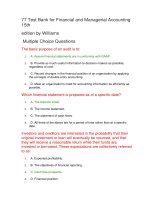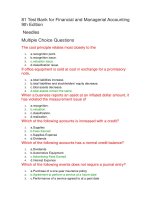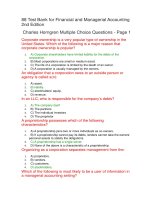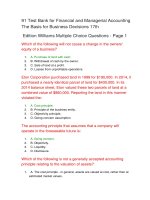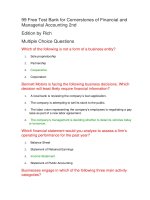Financial and managerial accounting 2nd kimel kieso willey chapter 18
Bạn đang xem bản rút gọn của tài liệu. Xem và tải ngay bản đầy đủ của tài liệu tại đây (3.7 MB, 51 trang )
18-1
18
Activity-Based Costing
Learning Objectives
18-2
1
Discuss the difference between traditional costing and
activity-based costing.
2
Apply activity-based costing to a manufacturer.
3
Explain the benefits and limitations of activity-based
costing.
4
Apply activity-based costing to service industries.
LEARNING
OBJECTIVE
1
Discuss the difference between traditional
costing and activity-based costing.
Traditional Costing Systems
Allocates overhead using a
predetermined rate.
►
Job order costing: direct labor
cost may be the relevant activity
base.
►
Process costing: machine hours
may be the relevant activity base.
Illustration 18-1
Traditional one-stage
costing system
18-3
LO 1
Illustration of a Traditional Costing System
Atlas Company produces two abdominal fitness products—the Ab
Bench and the Ab Coaster. The direct materials cost per unit is $40 for
the Ab Bench and $30 for the Ab Coaster. The direct labor cost is $12
per unit for each product. Both products require one direct labor hour
per unit, both products are allocated overhead cost of $30 per unit.
Illustration 18-3
Total unit costs—
traditional costing
18-4
LO 1
The Need for a New Approach
Tremendous
change in manufacturing and service
industries.
Decrease
in amount of direct labor usage.
Significant
increase in total overhead costs.
Inappropriate
to use plantwide predetermined overhead
rates when a lack of correlation exists.
Complex
manufacturing processes may require multiple
allocation bases; this approach is called activitybased costing (ABC).
18-5
LO 1
Activity-Based Costing
An approach for allocating overhead costs.
18-6
Allocates overhead to multiple activity cost pools.
Assigns the activity cost pools to products or services by
means of cost drivers.
LO 1
Activity-Based Costing (Four Steps)
18-7
1.
Identify and classify the activities involved in the
manufacture of specific products and assign overhead to
cost pools.
2.
Identify the cost driver that has a strong correlation to
the costs accumulated in each cost pool.
3.
Compute the activity-based overhead rate for each cost
pool.
4.
Allocate overhead costs to products using the
overhead rates determined for each cost pool.
LO 1
Activity-Based Costing
ABC allocates overhead in a two-stage process:
Stage 1: Overhead costs are assigned to activity cost
pools (Step 1).
Stage 2: Allocates overhead assigned to the activity cost
pools to products, using cost drivers (Steps 2-4).
The more complex a product’s manufacturing operation, the
more activities and cost drivers are likely to be present.
18-8
LO 1
Illustration 17-2
Activities and related cost drivers
18-9
Illustration 18-5
Activities and related cost drivers
LO 1
1
Costing Systems
Indicate whether the following statements are true or false.
1.A traditional costing system allocates overhead by means of multiple
overhead rates.
2.Activity-based costing allocates overhead costs in a two-stage process.
3.Direct material and direct labor costs are easier to trace to products than
overhead.
4.As manufacturing processes have become more automated, more
companies have chosen to allocate overhead on the basis of direct
labor costs.
5.In activity-based costing, an activity is any event, action, transaction, or
work sequence that incurs cost when producing a product.
Solution: 1. False.
18-10
2. True.
3. True.
4. False.
5. True.
LO 1
LEARNING
OBJECTIVE
2
Apply activity-based costing to a
manufacturer.
Activity-Based Costing
Involves the following four steps.
1.Identify and classify the activities involved in the manufacture
of specific products and assign overhead to cost pools.
2.Identify the cost driver that has a strong correlation to the
costs accumulated in each cost pool.
3.Compute the activity-based overhead rate for each cost pool.
4.Allocate overhead costs to products, using the overhead
rates determined for each cost pool.
18-11
LO 2
Identify and Classify Activities and Allocate
Overhead to Cost Pools (Step 1)
Overhead costs are assigned directly to the appropriate activity
Illustration 18-6
cost pool.
Activity cost pools and estimated overhead
18-12
LO 2
Identify Cost Drivers (Step 2)
Cost driver must accurately measure the actual consumption
of the activity by the various products.
Illustration 18-7: Cost drivers that Atlas Company identifies
and their total expected use per activity cost pool.
Illustration 18-7
18-13
LO 2
Compute Activity-Based Overhead Rates
(Step 3)
Next, the company computes an activity-based overhead rate
per cost driver.
Illustration 18-8
Illustration 18-9
18-14
LO 2
Allocate Overhead Costs to Products (Step 4)
In allocating overhead costs, it is necessary to know the
expected use of cost drivers for each product. Because of its
low volume and higher number of components, the Ab Coaster
requires more setups and purchase orders than the Ab Bench.
Illustration 17-8
Illustration 18-10
Expected use of cost
drivers per product
18-15
LO 2
Allocate Overhead Costs to Products (Step 4)
To allocate overhead costs, Atlas multiplies the activity-based
overhead rates per cost driver (Ill. 18-9) by the number of cost
drivers expected to be used per product (Ill. 18-10).
Illustration 18-11
Allocation of
activity cost pools
to products
18-16
LO 2
Allocate Overhead Costs to Products (Step 4)
To allocate overhead costs, Atlas multiplies the activity-based
overhead rates per cost driver (Ill. 18-9) by the number of cost
drivers expected to be used per product (Ill. 18-10).
Illustration 18-11
18-17
LO 2
Comparing Unit Costs
Illustration 17-10
Likely consequence of differences in assigning overhead.
18-18
Overpricing the Ab Bench and possibly losing market
share to competitors.
Sacrificing profitability by underpricing the Ab Coaster.
Illustration 18-12
Comparison of unit
product costs
LO 2
Management Insight
ABC Evaluated
Surveys of companies often show ABC usage of approximately 50%. Yet, in
recent years, articles about ABC have expressed mixed opinions regarding its
usefulness. To evaluate ABC practices and user satisfaction with ABC, a survey
was conducted of 348 companies worldwide. Some of the interesting findings
included the following: ABC methods are widely used across the entire value
chain, rather than being primarily used to allocate production-specific costs;
only 25% of non-ABC companies think they are accurately tracing the costs of
activities, while 70% of ABC companies think their company does this well; and
respondents felt that ABC provides greater support for financial, operational,
and strategic decisions. More than 87% of respondents said that their ideal
costing system would include some form of ABC. Since this significantly
exceeds the 50% of the respondents actually using it, ABC usage may well
increase in the future.
Source: William Stratton, Denis Desroches, Raef Lawson, and Toby Hatch, “ActivityBased Costing: Is It Still Relevant?” Management Accounting Quarterly (Spring, 2009),
pp. 31–39.
18-19
LO 2
2
Apply ABC to Manufacturer
Casey Company has five activity cost pools and two products. It expects to
produce 200,000 units of its automobile scissors jack and 80,000 units of
its truck hydraulic jack. Having identified its activity cost pools and the cost
drivers for each cost pool, Casey Company accumulated the following data
relative to those activity cost pools and cost drivers.
18-20
LO 2
2
Apply ABC to Manufacturer
Casey Company has five activity cost pools and two products. It expects to
produce 200,000 units of its automobile scissors jack and 80,000 units of
its truck hydraulic jack. Having identified its activity cost pools and the cost
drivers for each cost pool, Casey Company accumulated the following data
relative to those activity cost pools and cost drivers.
Using the data provided,
a.Prepare a schedule showing the computations of the activity-based
overhead rates per cost driver.
b.Prepare a schedule assigning each activity’s overhead cost to the
two products.
c.Compute the overhead cost per unit for each product.
d.Comment on the comparative overhead cost per unit.
18-21
LO 2
2
Apply ABC to Manufacturer
a. Prepare a schedule showing the computations of the activity-based overhead rates per cost driver.
18-22
LO 2
2
18-23
b.Prepare a schedule assigning each activity’s
overhead cost to the two products.
LO 2
2
Apply ABC to Manufacturer
c. Compute the overhead cost per unit for each product.
d. Comment on the comparative overhead cost per unit.
These data show that the total overhead assigned to 80,000 hydraulic
jacks exceeds the overhead assigned to 200,000 scissors jacks. The
overhead cost per hydraulic jack is $34.25. It is only $12.80 per
scissors jack.
18-24
LO 2
LEARNING
OBJECTIVE
3
Explain the benefits and limitations of
activity-based costing.
ABC has three primary benefits:
1. More cost pools, therefore more accurate product costing.
2. Enhanced control over overhead costs.
3. Better management decisions.
18-25
LO 3



